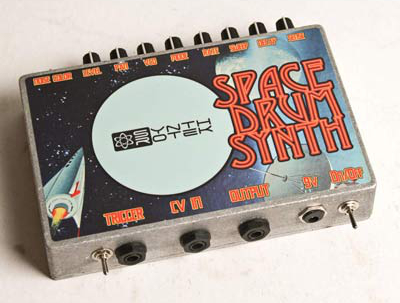Important Links
Product Page
Store Page
Assembly Instructions
Bill of Materials
Schematics
Drill Template
Capacitor and Resistor Lookup Guide
The DS-8 Drum Synth Clone is one of our favorite circuits!
Originally designed by Coron in the 1980’s for drummers and percussionists to add synth capabilities to their sets, our clone stays true to the DS-8 Drum Synth circuit with a few modifications that expand its capabilities. You don’t need to be banging out beats to play around with this awesome synth!
Features:
- Amazing analog signal generation! – Wobbly lows, screeching sirens, dive bombs, squeals, and everything in-between. On-board pannable white noise generator puts out snare and hi-hat hits!
- Three different ways to play: use a piezo cell to trigger it like a real drum, send a Trigger/Gate pulse (~+5V) from a sequencer/simple timer circuit, or activate the DS-8 Clone with the on-board Manual Trigger momentary switch!
- Multiple controls to tailor your sound! Sensitivity sets your input threshold to adjust how hard you need to hit or the minimum voltage level to trigger the circuit. The length of the trigger pulse can be varied from staccato to a lengthy drop-off with the Decay control. Sweep adjusts the variation of the output frequency. The analog LFO (low frequency oscillator) circuitry is controlled by the Mode and Rate. VCO (voltage controlled oscillator) sets a base level frequency to limit your frequency range. Dirty up your signal with the Pan control, which varies the amount of white noise you’ll need for snare hits or deep tom rumble. Level controls the volume of the final VCA (voltage controlled amplifier) portion of your circuit.
- All potentiometers used for customizing your sound can be mounted on-board to minimize time-consuming wiring.
- Tone Control switch allows you to toggle between the two standard noise sources.
- CV Input makes the DS-8 Clone even better! Plug in an external LFO generator or use a sequencer to make some hands-free music!
- Powering your DS-8 Clone is no problem! Use a 9V battery or save some cash and use a 9-15V >= 100mA AC Adapter. The 9V battery also can act as a backup power supply that is only engaged when nothing is plugged into the DC Jack.
- PCB (printed circuit board) measures 6″ x 2.0625″ and is designed in-house by our very own electronics engineer!





I play a Moog Etherwave Plus theremin, which has CV outputs on the volume and pitch plus a gate output. The volume CV runs from something like -2.5v to +4.5v, the pitch output runs from 0 to 10 volts, and the gate run at 0 or 10 volts. While I can follow a schematic, I don’t know enough to know if those output voltages will work out of the box with the DS-8, or if I’ll not what type of circuitry would be needed to get the voltages into compatible ranges. I’m thinking those two pieces of hardware could work well together, even if it takes some tweaking. I’ve poked around on the web and haven’t seen mention of them together, and would love to be among the first to experiment with controlling the DS-8 with a theremin. Do you have any advice?
To bring a normal +-5v input usually a pair of schottky diodes 1N5819 and a 10k resistor are used as an input ladder / buffer to drop the voltage to safe. Admin chime in ?
Hi Mike, we are using a voltage regulator to bring this down to 5
Hello, is it possible to connect multiple DS8’S together say about five, so they share the same power source and on off switch? Thanks